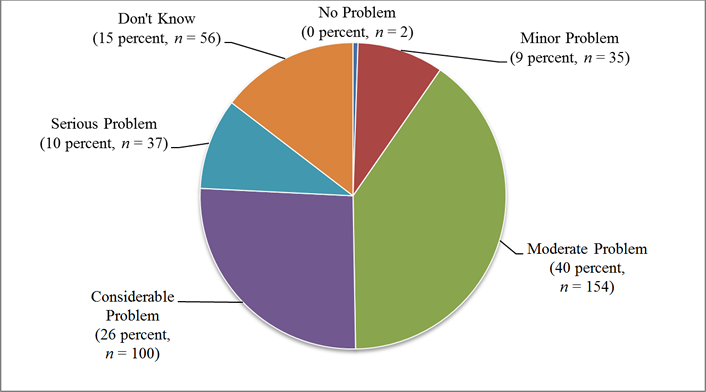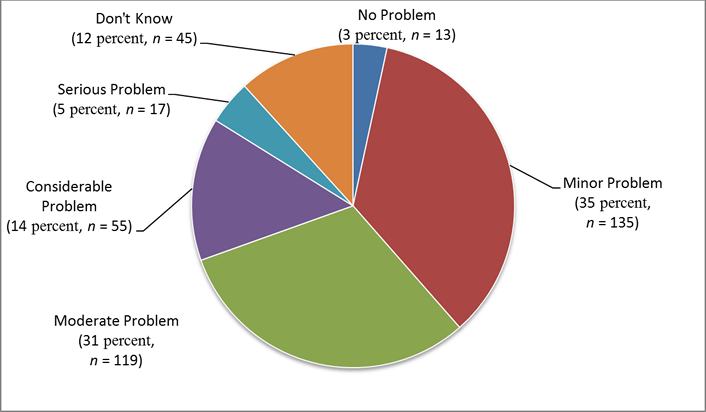Key Takeaways
- Research into cyberbullying in higher education found that respondents recognized it as an issue among college students, but believed it to be more serious at other institutions than their own.
- The perceived extent of the cyberbullying problem at one's own institution versus elsewhere revealed the possibility of a group-serving bias among the survey respondents.
- The research results are serving to inform institutional leaders regarding what their constituents understand about cyberbullying within higher education, as well as decision making, training needs, and policy on campuses.
Cyberbullying is a problem within higher education, but more so at other institutions than my own.
According to research that I recently conducted on cyberbullying in higher education, this hypothetical quote is how many of the participants understand its current state.1 Specifically, I found that faculty, staff, and administrators recognize cyberbullying as an issue among college students; however, when compared to their institution of employment, they perceive the issue to be more serious elsewhere. Obviously, if everyone believes this way, not everyone can be right. What's going on? My research into the matter suggests a group-serving bias at work.
The Cyberbullying Study and Results
In late 2014 I conducted a study that investigated perceptions held by faculty, administrators, and staff (N = 384) regarding cyberbullying behavior within higher education; the majority (n = 331) of respondents represented institutions in the United States. One aspect of the study implemented a 28-item online cyberbullying survey that I adapted with permission.2 This survey investigates perceptions regarding cyberbullying behavior at the postsecondary level. Two of its items ask participants to gauge the extent to which cyberbullying is a problem at their institution versus a problem at other institutions. I found that participants in my study exhibited a group-serving bias regarding this matter.
A group-serving bias is a social psychological concept defined as "Explaining away outgroup members' positive behaviors; also attributing negative behaviors to their dispositions (while excusing such behavior in one's own group)."3 This bias "inflates people's judgments of their groups"; in addition, "When groups are comparable, most people consider their own group superior."4
The majority of participants who completed the cyberbullying survey agreed that cyberbullying is a problem both at their institution and elsewhere (84.49 percent and 84.89 percent, respectively). In fact, 41 percent of participants reported that cyberbullying occurs monthly, if not more frequently, at their institution. The perceived extent of the problem at one's own institution versus elsewhere, however, is where the group-serving bias becomes evident. Specifically, the problem of cyberbullying was perceived to be more "moderate" (40 percent versus 31 percent), more "considerable" (26 percent versus 14 percent), or more "serious" (10 percent versus 5 percent) at other institutions than at one's own institution (figure 1). Conversely, participants also felt that the problem of cyberbullying is more "minor" (35 percent versus 9 percent) or "not a problem" (3 percent versus 0 percent) at their own institution than at other institutions (figure 2). This interesting overall data pattern could suggest that a group-serving bias exists.

Figure 1. "In your opinion, to what extent is cyberbullying a problem at other higher education institutions?"; item 13

Figure 2. "In your opinion, to what extent is cyberbullying a problem at your institution?"; item 12
Survey participants' perceptions of the cyberbullying problem experienced at their institutions indicate a positive bias compared to their perception of the cyberbullying problem at other institutions. Simply put, the participants in the study appear to feel that cyberbullying is a problem, but more so at other institutions than at their own. This misperception suggests that educators may be misinformed about the realities of cyberbullying within higher education.
Group-Serving Bias and Cyberbullying
It's difficult to discern what contributed to the group-serving bias found in the study. I can only surmise that those who responded are unclear about the realities of cyberbullying within higher education and that this misconception may have influenced the group-serving bias phenomenon. Left unchecked, however, I believe that a group-serving bias has the potential to negatively affect an institution's ability to handle incidents of cyberbullying. If faculty, administrators, or staff feel that their institution does not struggle with cyberbullying to the same extent as other institutions, opportunities to address cyberbullying in a proactive manner could be downplayed or ignored. Also, victims of cyberbullying might feel unsupported, misunderstood, or hesitant to come forward under these conditions. Current research suggests that only a small percentage of students come forward to report cyberbullying now.5 More research on this topic is under way, and the results should help institutions improve or establish policies against it and programs to support the victims.
I am in the process of replicating my research on perceptions of cyberbullying within higher education and will be seeking more information about the group-serving bias evidenced in my original data to determine if a group-serving bias truly exists, and why. I am also expanding the scope of the study to include a more representative sample of institutional constituents within other countries as well.
The results of my work are serving to inform institutional leaders regarding what their constituents understand about cyberbullying within higher education, as well as decision making, training needs, and policy on campuses. A larger, broader sample will undoubtedly shed more light on the matter.
Notes
- Julie Luker, "Perceptions of Cyberbullying within Higher Education" (doctoral dissertation, Hamline University, Saint Paul, Minnesota, 2015).
- Sterling Stauffer, "High School Teachers' Perceptions of Cyber Bullying Prevention and Intervention Strategies" (educational specialist thesis, Brigham Young University, Provo, Utah, 2011); Sterling Stauffer, Melissa Ann Heath, Sarah Marie Coyne, and Scott Ferrin, "High School Teachers' Perceptions of Cyberbullying Prevention and Intervention Strategies," Psychology in the Schools 49, no. 4 (2012): 353–67.
- David Myers, Social Psychology, 10th ed. (New York: McGraw-Hill, 2010), S4.
- Ibid., 71.
- Jerry Finn, "A Survey of Online Harassment at a University Campus," Journal of Interpersonal Violence 19 (2004): 468–83; "Cyber Bullying Statistics 2014," [http://nobullying.com/cyber-bullying-statistics-2014/] NoBullying.com, last modified May 27, 2015.
Julie Luker is an adjunct professor, researcher, educational consultant, and certified Quality Matters (QM) Peer Reviewer at several institutions of higher education. She has 15 years of higher education experience, including administration, admissions, advising, and teaching. Her academic background includes a Bachelor of Arts degree from The University of St. Thomas, a Master of Arts degree in cognitive and social processes from Ball State University, and a doctorate in education from Hamline University.
© 2015 Julie Luker. The text of this EDUCAUSE Review article is licensed under Creative Commons BY-NC-SA 4.0 International.
